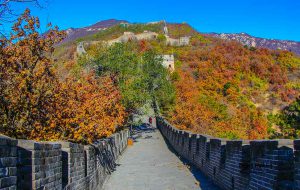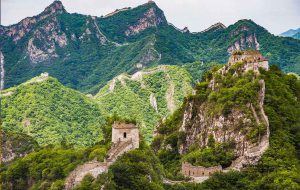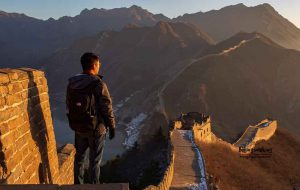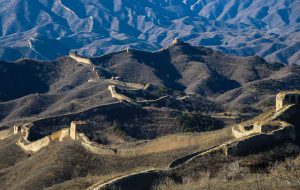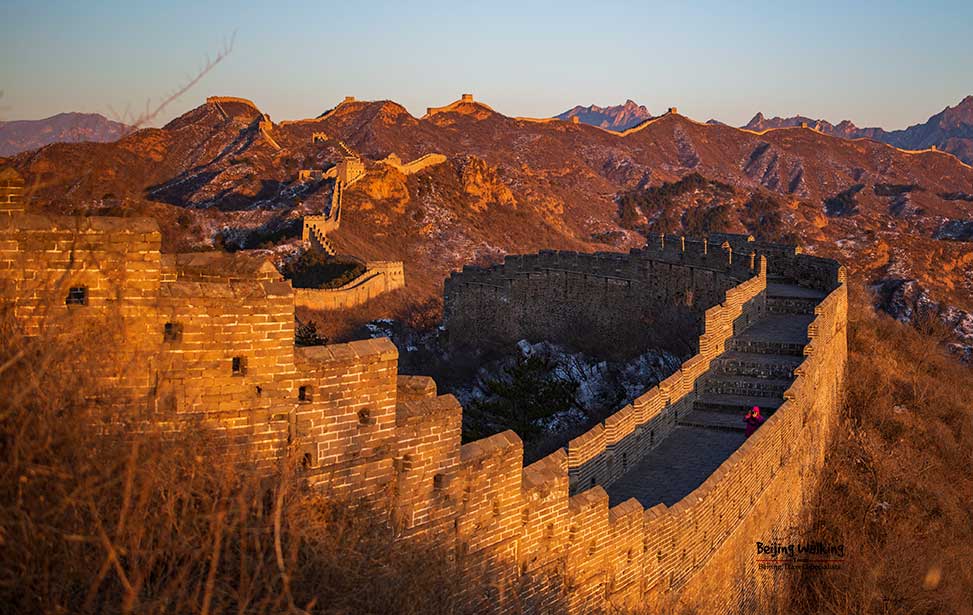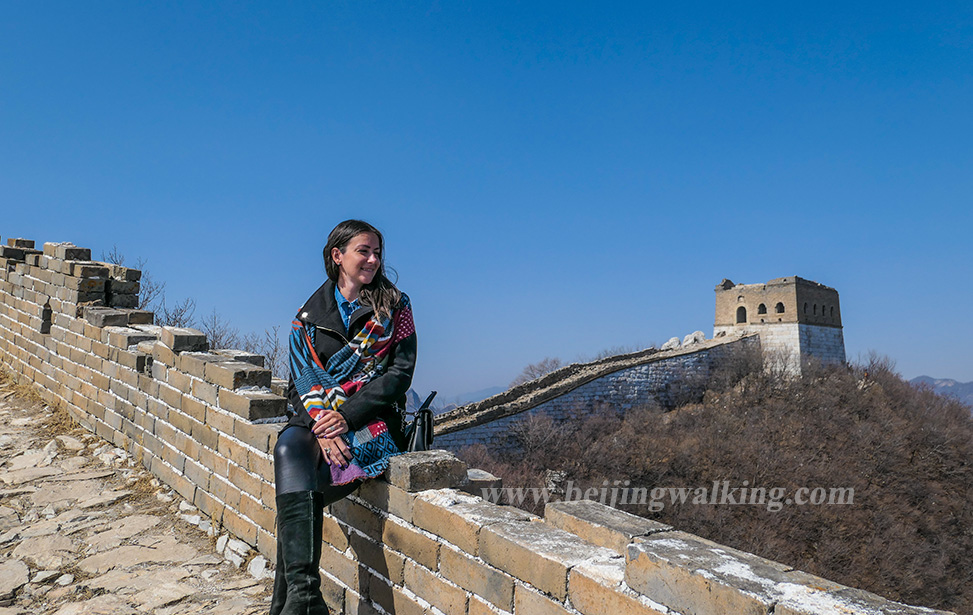Discovering the Great Wall: Top 20 Fascinating Facts
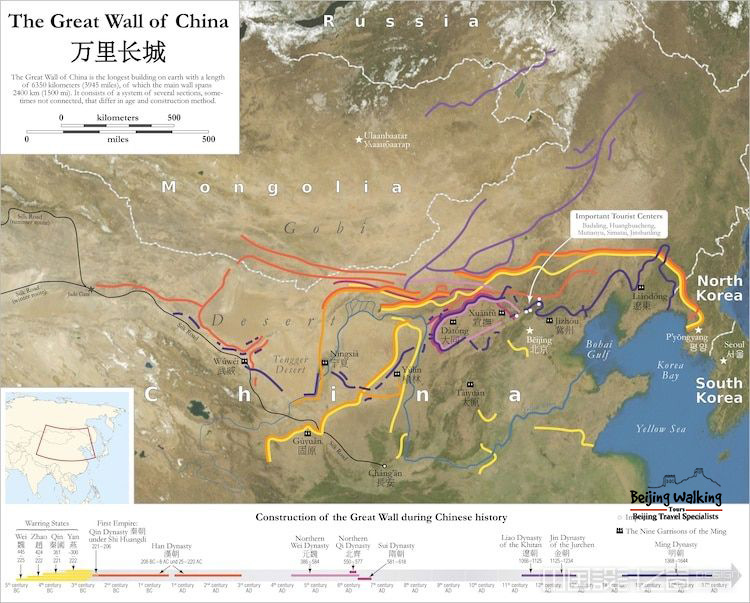
The Great Wall of China, an iconic symbol of China’s rich history and architectural prowess, is a testament to the ingenuity and determination of the ancient Chinese civilization. Stretching over 21,000 kilometers, it is the most extended artificial structure in the world. This comprehensive guide will explore the Great Wall’s fascinating facts and hidden secrets, from its construction and purpose to its diverse landscapes and cultural significance.
Quick Facts About the Great Wall of China
- Length and Span: The Great Wall stretches 21,196 kilometers (13,171 miles) across northern China, making it the most extended man-made structure on Earth.
- Qin Dynasty Origins: The earliest walls that laid the foundation for the Great Wall were built during the Qin Dynasty (221-206 BC) under Emperor Qin Shi Huang.
- Myth of Visibility from Space: Contrary to popular belief, the Great Wall cannot be seen from space with the naked eye. It is not wide enough to be visible from such a distance.
- Varying Heights and Widths: The height and width of the Great Wall vary along its length, ranging from 5 to 8 meters (16 to 26 feet) in size and 4 to 5 meters (13 to 16 feet) in width.
- Battlements and Crenellations: The wall’s battlements and crenellations allowed soldiers to defend it effectively, featuring alternating high and low sections.
- Strategic Passes: The wall features strategic passes, such as the famous Jiayuguan and Shanhaiguan Passes, which serve as vital gateways and checkpoints.
- Architectural Diversity: The Great Wall showcases diverse architectural styles and techniques influenced by the different dynasties and regions involved in its construction.
- Ancient Transportation Network: The Great Wall served as a transportation network, facilitating the movement of troops, goods, and information across vast distances.
12 Great Wall Facts in detail
1. How old is the Great Wall?
Most people believe the Great Wall’s history can be ascended back to 200 BC. But most of the wall from that time or later is only some mounds of dirt today. The wall we see is from the Ming Dynasty, with the masonry structure about 500 years old.
The construction of the Great Wall of China is an engineering marvel that spans over 2,300 years of history. It was not a single project undertaken at once but a series of walls and fortifications built by different dynasties and rulers to protect the Chinese Empire from invasion. The earliest known sections were built as early as the 7th century BC during the Spring and Autumn Periods. These walls were constructed using simple techniques such as stamping Earth and gravel between board frames.
2. The Great Wall: A Series of Marvels
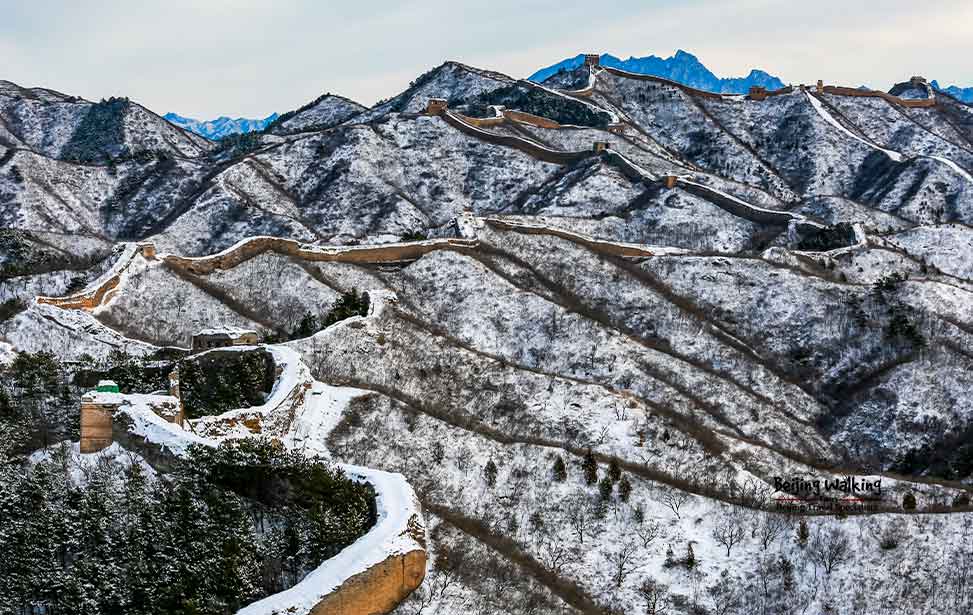
Contrary to popular belief, the Great Wall of China is not a single continuous structure but a collection of walls, towers, trenches, and moats spanning a vast expanse of China’s northern border. The entire wall, including all its branches and spurs, is estimated to stretch over 21,000 kilometers (13,000 miles). This staggering length is equivalent to half the circumference of the Earth.
The Great Wall is strategically built along the natural defensive features of the landscape, such as mountain ranges, hills, and rivers. In some areas, the wall follows the crestlines of mountains, snaking its way through rugged terrains. In others, it utilizes natural barriers, such as cliffs and deep gorges, to provide additional protection. The builders demonstrated remarkable ingenuity by adapting their construction techniques to the unique topography of each region.
The wall is punctuated by numerous watchtowers and fortifications that serve as lookout points and defensive positions. These structures vary in size and design, showcasing the architectural diversity of the different dynasties that contributed to the wall’s construction. Some sections of the wall feature imposing gateways, while others incorporate defensive elements such as bastions and battlements. Each wall segment has its distinct character, reflecting the historical and cultural influences of the time it was built.
3. Materials and Techniques: From Earth to Sticky Rice
The Great Wall of China’s construction relied on various materials and techniques, which evolved as builders experimented with different methods to enhance the wall’s durability and strength. The earliest wall sections were constructed using locally available resources, such as Earth and stone. Builders stamp Earth and gravel between wooden frames to create solid wall sections.
As the construction techniques evolved, builders began incorporating more advanced materials, such as bricks and cut stones. Using bricks became prevalent during the Ming Dynasty, which saw the wall’s significant expansion and reinforcement. Bricks were made from clay, sand, and lime and fired in kilns to ensure durability. These bricks were then used to construct the outer layers of the wall, providing a smooth and sturdy surface.
One of the most fascinating aspects of the Great Wall’s construction is using sticky rice as a bonding material. Glutinous rice flour was mixed with lime to create a mortar to bind the bricks and stones together. This damp rice mortar proved highly effective, providing a solid and water-resistant bond. The use of sticky rice mortar is a testament to ancient Chinese engineers’ ingenuity and ability to utilize local resources innovatively.
4. A Monumental Defense: Protecting China’s Borders
The primary purpose of the Great Wall of China was to serve as a formidable defense against invading forces. It was designed to protect China’s northern border from the constant threat of nomadic tribes and other potential aggressors. The wall’s strategic location allowed the Chinese Empire to control and monitor the movement of people and goods across its borders.
The Great Wall acted as a physical barrier, making it difficult for enemy forces to penetrate China’s territories. Its imposing height, sheer length, and strategic placement along natural defensive features presented a formidable obstacle to would-be invaders. The wall was further fortified by numerous watchtowers, which provided an elevated vantage point for surveillance and communication.
In addition to its defensive role, the Great Wall symbolized China’s imperial power and authority. Its grandeur and scale were intended to impress and intimidate potential adversaries, conveying a message of strength and unity. The wall’s construction became a symbol of national identity and collective effort, reinforcing the sense of patriotism and pride among the Chinese people.
5 . Qin Shihuang was not the first King to build the Great Wall
Five hundred years before Qin Shihuang unit China (211 BC), all the states in the north had their long wall built for defense. They are Qi, Chu, Yan, Han, Zhao, Wei, Qin. Emperor Qin Shihuang decided to unite all the walls together. So the 5000 km long wall came into being.
6. Marco Polo did see the Great Wall.
Marco Polo didn’t mention the Great Wall in his book, which proves he never came to China. Marco Polo came to China during Kublai Khan’s reign of the Yuan Dynasty. The last construction of the Great Wall was 600 years ago. The Great Wall, built before the Ming Dynasty, is not masonry, so it should not be as great as today. There may be only some little mound left. I think that’s why Marco Polo didn’t mention the Great Wall in his book.
7. Can you see the Great Wall from the moon?
Over the centuries, many myths and misconceptions surrounding the Great Wall of China have emerged. It is important to distinguish fact from fiction to appreciate this iconic structure’s historical and cultural significance fully.
Contrary to popular belief, the Great Wall of China cannot be seen from space with the naked eye. The myth that it is visible from the moon originated in the 18th century and has been perpetuated through various sources. While the wall is an impressive feat of engineering, its width and materials do not make it visible from such a great distance. However, it may be visible from low Earth orbit with advanced imaging technology under ideal conditions.
8. Exploring the Great Wall: From East to West
The Great Wall of China stretches across a vast expanse of northern China, covering a distance of over 21,000 kilometers. It spans multiple provinces and municipalities, offering unique landscapes and cultural experiences. From east to west, let’s explore some of the most notable sections of the Great Wall.
- Mutianyu
- Jiankou
- Huanghuacheng
- Gubeikou
The Badaling Section: A Popular Gateway
The Badaling section is one of the most well-known and accessible sections of the Great Wall. Located just 70 kilometers northwest of Beijing, it attracts millions of visitors annually. This section has been meticulously restored and offers a glimpse into the grandeur of the Ming Dynasty’s construction. Visitors can stroll along the wall, admire the panoramic views, and explore the watchtowers that once served as lookout points and defensive positions.
The Mutianyu Section: Beauty in Tranquility
The Mutianyu section is renowned for its breathtaking scenery and tranquility. It is approximately 70 kilometers northeast of Beijing and offers a less crowded alternative to the popular Badaling section. Visitors can take a cable car or hike up to the wall and marvel at its well-preserved condition. The Mutianyu section is known for its dense forest coverage and picturesque views, making it a favorite among nature enthusiasts and photographers.
The Jinshanling Section: A Hiker’s Paradise
The Jinshanling section is an excellent choice for those seeking a more adventurous experience. Located in Hebei Province, it offers a challenging hike with stunning panoramic views of the surrounding countryside. This section is known for its well-preserved watchtowers and diverse architectural features. Hikers can traverse the undulating terrain and appreciate the craftsmanship and strategic design of the wall.
The Simatai Section: A Glimpse into the Past
The Simatai section provides a glimpse into the rugged and authentic nature of the Great Wall. It is situated in Beijing’s northeastern outskirts and offers a more rustic and less crowded experience than other sections. The Simatai section is known for its steep slopes and original Ming Dynasty construction. Visitors can witness the wall’s weathered beauty and explore its watchtowers and fortifications.
The Huanghuacheng Section: A Unique Waterside Wall
The Huanghuacheng section is distinguished by its unique location along a picturesque lakeside. Situated in Beijing’s Huairou District, it combines the Great Wall’s grandeur with the serenity of the water. Visitors can enjoy a leisurely walk along the wall, admire the reflection of the wall on the lake’s surface, and appreciate the harmonious integration of nature and architecture.
These sections represent just a fraction of the vast network of walls and fortifications that make up the Great Wall of China. Each unit offers a unique perspective on the wall’s history, construction techniques, and cultural significance. Exploring these sections provides an opportunity to delve into China’s rich heritage and appreciate the enduring legacy of this remarkable structure.
9. Preserving the Past: Challenges and Conservation
Preserving the Great Wall of China is a monumental task that requires ongoing efforts in conservation and restoration. The wall’s immense length and diverse geographical locations present unique challenges in maintaining its structural integrity and historical authenticity.
Natural erosion, weathering, and human encroachment threaten the wall’s preservation. Over time, border sections have suffered from deterioration caused by wind, rain, and temperature fluctuations. Vegetation growth and human activities, such as unauthorized construction and tourism, can also impact the wall’s condition.
Various organizations and government authorities are involved in ongoing conservation and restoration projects to address these challenges. These initiatives aim to protect the wall’s physical integrity, promote sustainable tourism practices, and raise awareness of the cultural and historical significance of the Great Wall.
Conservation efforts involve a delicate balance between preserving the authenticity of the wall and ensuring visitor access and enjoyment. Techniques such as stabilizing crumbling sections, reinforcing damaged portions, and implementing visitor management plans are employed to strike this balance.
The Great Wall of China is a national treasure and a global cultural heritage. Its preservation requires a collaborative and multidisciplinary approach involving archaeology, architecture, engineering, and cultural heritage management experts. The Great Wall can inspire awe and admiration for future generations through these collective efforts.
10. The Great Wall in Popular Culture
The Great Wall of China has captured the imagination of people worldwide and has been featured in various forms of popular culture. Its grandeur, historical significance, and mythical allure have made it a subject of fascination and inspiration in literature, film, and art.
In literature, the Great Wall has been depicted as a symbol of strength, resilience, and the indomitable spirit of the Chinese people. It has been a backdrop for epic tales of heroism, adventure, and romance. Authors like Franz Kafka, Jorge Luis Borges, and Haruki Murakami have referenced the Great Wall in their works, weaving its symbolism into their narratives.
In film, the Great Wall has provided a stunning backdrop for epic historical dramas and action-packed adventures. Movies such as “Hero” (2002), “The Great Wall” (2016), and “Mulan” (2020) have showcased the wall’s grandeur and its significance in Chinese history and culture.
Chinese and international artists have been captivated by the Great Wall’s majestic beauty and historical significance. Paintings, sculptures, and photographs have sought to capture its essence, showcasing its architectural splendor and breathtaking landscapes.
The Great Wall’s presence in popular culture has further elevated its status as a global icon and a symbol of China’s rich cultural heritage. It inspires awe and curiosity, inviting people worldwide to explore its history, marvel at its grandeur, and appreciate its enduring legacy.
11. A Symbol of Chinese Identity
The Great Wall of China is not just a physical structure but a symbol of Chinese identity and national pride. It embodies the resilience, determination, and unity of the Chinese people throughout history. The wall’s construction, preservation, and cultural significance have become integral to the collective memory and heritage of the Chinese nation.
As a testament to human engineering and ingenuity, the Great Wall represents the remarkable achievements of ancient civilizations and their ability to overcome challenges. It is a reminder of the power of collective effort, the importance of cultural heritage, and the enduring legacy of human achievements.
For the Chinese, the Great Wall is a source of inspiration, national unity, and a connection to their ancestors. It serves as a reminder of the rich history, cultural diversity, and technological advancements that have shaped China’s past and continue to influence its future.
12. The Great Wall Today: A Living Legacy
The Great Wall of China continues to be a vibrant and living monument, attracting millions of visitors worldwide each year. Its historical and cultural significance and awe-inspiring beauty make it a must-visit destination for travelers seeking to immerse themselves in China’s rich heritage.
The Chinese government and various organizations are dedicated to preserving and conservating the Great Wall. Restoration efforts focus on maintaining the wall’s structural integrity, protecting it from natural erosion and human encroachment, and promoting sustainable tourism practices.
Visitors to the Great Wall can witness the ongoing conservation work and learn about the wall’s history through informative exhibits and interpretive signage. These initiatives aim to balance preserving the wall’s authenticity and providing visitors with a memorable and educational experience.
In addition to its cultural and historical significance, the Great Wall symbolizes unity and pride for the Chinese people. It represents the shared heritage and achievements of countless generations who contributed to its construction and preservation. The wall’s enduring presence is a testament to the Chinese nation’s ingenuity, resilience, and collective spirit.
Final Thoughts
The Great Wall of China is a testament to human engineering, perseverance, and cultural heritage. Spanning over 2,300 years of history, it is a remarkable feat of construction that continues to inspire awe and admiration.
From its origins as a series of walls and fortifications built to protect China’s borders to its transformation into a global icon, the Great Wall has captured the imagination of people around the world. Its grandeur, historical significance, and mythical allure make it a symbol of China’s rich heritage and a testament to the achievements of human civilization.
Visiting the Great Wall is a journey through time, an opportunity to walk in the footsteps of ancient builders and experience the breathtaking landscapes surrounding this architectural wonder. It is a chance to appreciate the craftsmanship, ingenuity, and cultural legacy that have shaped China’s past and continue to shape its future.
As you explore the Great Wall, let its towering walls and sweeping vistas remind you of the human capacity for greatness and the enduring power of cultural heritage. The Great Wall of China is more than a physical structure; it is a testament to the human spirit’s resilience, unity, and creativity.
When you get into this post, you must read quite something about the Great Wall of China and know some of the facts about her. But after deep research and work on the Great Wall, I conclude the Top 12 Great Wall Facts you probably don’t know.
